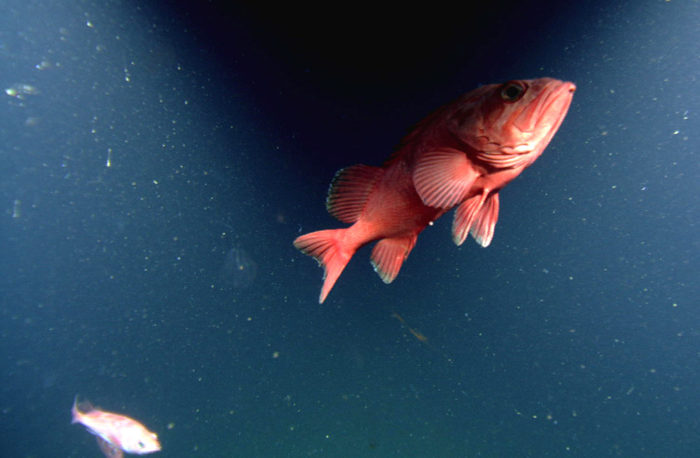Deepsea: Bocaccio Rockfish
Bocaccio is one of at least 35 species of rockfish found in British Columbia. In the past 10 years it has declined 28 per cent, according to the Canadian government. Bocaccio are threatened mostly by commercial groundfish fisheries. Their swim bladders, unlike those of other rockfish species, are unable to adapt to the sudden change in pressure when rapidly brought to the surface by fishing nets.
Read more about this endangered species and take action to protect the health of Canadian oceans. You can add your name to our petition and make the Pacific Deepsea Oasis a Marine Protected Area.
Vital Signs
Common name: Bocaccio
Latin name: Sebastes paucispinis
Status under SARA: Endangered
Range: Northeastern Pacific Ocean, from the gulf of Alaska to central Baja California in Mexico, 60-340 metres deep
Life Span: maximum of 57 years
Size: up to 91 cm
Population estimate: 400,000 individuals

Rockfish (pictured here) are common off the coast of British Columbia, but Bocaccio species is endangered. Courtesy Ocean Networks Canada.
Facts
- During their lifespan, a female Bocaccio can produce up to 2,300,000 eggs.
- The average Bocaccio generation time is 20 years.
- One of at least 35 species of Rockfish found in the waters of British Columbia
- Other common names for Bocaccio include: Rock Salmon, Salmon Rockfish, Pacific Red Snapper, Pacific Snapper, Oregon Red Snapper, Oregon Snapper, and Longjaw
- When the young Bocaccio is under 25 cm in length, it is light bronze with small spots on its side that disappear as its skin coat darkens with age.
- They are distinguished from other Rockfish by its long lower jaw
- 2 demographic clusters of Bocaccio, one on the west coast of British Columbia and other on coast of central/southern California
- They begin their lives living near the water’s surface, moving to nearshore areas to form schools.
- Adults are commonly found over rocky high relief bottom at depths of 60-340 metres.
In 2004, Fisheries and Oceans Canada addressed the decline in Bocaccio by working with industry to develop a conservation program for the species. The plan stipulates that all profits earned from catching Bocaccio be directed to conservation programs for species recovery, that trawl surveys be conducted to improve knowledge of the species and that the impacts of commercial fishing be managed through a Total Allowable Catch (TAC) and other limits on the number of individuals caught.
The number of groundfish trawl licenses was also restricted and additional monitoring was put into place to keep the commercial industry accountable. Marine Protected Areas and Rockfish Conservation Areas also help protect groundfish habitat.
What can you do to help protect Bocaccio?
Because they live at deeper levels of the ocean and can’t survive sudden pressure changes, these rockfish are vulnerable to deep-sea fishing. It’s important to give these animals safe places to reproduce and build up populations. One way to do that is to designate more areas for conservation.
Sign our petition asking the federal government to make the Deepsea Oasis a Marine Protected Area!



